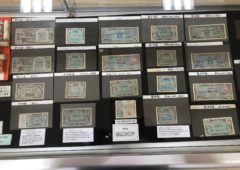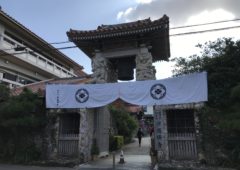2013.08.29
Ramen: simple or complex but always tasty
By Bill Charles

A bowl of hot ramen is the quintessential Japanese fast food meal, often accompanied with with a couple of gyoza dumplings.
To the uninitiated, ramen is a simple Japanese noodle dish that has also found its way into modern packaging than lends itself to simple cooking at home. But is it?
Actually, no. Ramen is anything but simple. It’s complex, with varying styles of preparation in different parts of Japan. About the only thing simple is that the basics involve only four ingredients: wheat flour, salt, and kansui, which is essentially a type of alkaline mineral water, containing sodium carbonate and usually potassium carbonate, as well as sometimes a small amount of phosphoric acid. From there, the noodles are made, then served with meat or fish-based broth sometimes flavored with miso or soy sauce, and then mixed with toppings that include sliced pork, dried seaweed, kamaboko green onions, and sometimes corn.
Ramen noodles originated in China, and nobody really knows when or how it got to Japan. Some theorize that it’s a variation on lamian, meaning hand-pulled noodles, while other translations of lamian are old noodles, noodles cooked in a thick, starchy sauce, or lo mein, meaning to stir. Any way the pot is stirred, it was called Chinese soba until the 1950s.
The instant noodles were invented in 1958 by Momofuku Ando, the Taiwanese-Japanese founder and chairman of Nissin foods. In Japanese polls, the instant ramen has been billed as the greatest Japanese invention of the 20th century. Ramen has progressed to be a Japanese cultural icon, copied with varying degrees of good taste in many countries.
Ramen comes in various shapes and lengths. It may be thick, thin, or even ribbon-like, as well as straight or wrinkled. That’s where the ‘simple’ stops. There isn’t one Ramen. Combinations of ingredients have led to four distinct types of ramen.
- Shio (“salt”) ramen is probably the oldest of the four and is a pale, clear, yellowish broth made with plenty of salt and any combination of chicken, vegetables, fish, and seaweed. Occasionally pork bones are also used, but they are not boiled as long as they are for tonkotsu ramen, so the soup remains light and clear.
- Tonkotsu (豚骨, “pork bone”; not to be confused with tonkatsu) ramen usually has a cloudy white colored broth. It is similar to the Chinese baitang and has a thick broth made from boiling pork bones, fat, and collagen over high heat for many hours, which suffuses the broth with a hearty pork flavor and a creamy consistency that rivals milk, melted butter or gravy (depending on the shop). It is a specialty of Kyushu, particularly Hakata-ku, Fukuoka.
- Shōyu (“soy sauce”) ramen typically has a clear brown broth, based on a chicken and vegetable (or sometimes fish or beef) stock with plenty of soy sauce added resulting in a soup that is tangy, salty, and savory yet still fairly light on the palate. Shōyu ramen usually has curly noodles rather than straight ones, and is often adorned with marinated bamboo shoots or green onions, kamaboko (fish cakes), nori (seaweed), boiled eggs, bean sprouts and/or black pepper.
- Miso ramen is the newcomer, around since 1965., This uniquely Japanese ramen, which was developed in Hokkaido, features a broth that combines copious amounts of miso and is blended with oily chicken or fish broth – and sometimes with tonkotsu or lard – to create a thick, nutty, slightly sweet and very hearty soupThe noodles are typically thick, curly, and slightly chewy.
Seasonings commonly added to ramen are black pepper, butter, chili pepper, sesame seeds, and crushed garlic. Soup recipes and methods of preparation tend to be closely guarded secrets
Virtually every prefecture and city has its own specialty, or variation on ramen.
Sapporo, the capital of Hokkaido, is especially famous for its ramen. Sapporo miso ramen is typically topped with sweet corn, butter, bean sprouts, finely chopped pork, and garlic, and sometimes local seafood such as scallop, squid, and crab.
Kitakata in northern Honshu is known for its rather thick, flat, curly noodles served in a pork-and-niboshi broth.
Tokyo style ramen consists of slightly thin, curly noodles served in a soy-flavoured chicken broth. The Tokyo style broth typically has a touch of dashi, as old ramen establishments in Tokyo often originate from soba eateries.
Yokohama ramen specialty consists of thick, straight-ish noodles served in a soy flavored pork broth similar to tonkotsu. The standard toppings are roasted pork, boiled spinach, sheets of nori, often with shredded Welsh onion and a soft or hard boiled egg.
Hakata ramen originates from Hakata district of Fukuoka city in Kyushu. It has a rich, milky, pork-bone tonkotsu broth and rather thin, non-curly and resilient noodles. Often, distinctive toppings such as crushed garlic, pickled ginger, sesame seeds, and spicy pickled mustard greens are left on tables for customers to serve themselves.
Over the next few weeks, Japan Update will introduce some selected ramen shops on Okinawa.


 2024.06.08
2024.06.08 2024.05.25
2024.05.25 2024.04.26
2024.04.26 2024.04.22
2024.04.22 2024.04.10
2024.04.10 2024.01.31
2024.01.31 2024.01.02
2024.01.02 2023.12.27
2023.12.27 2023.11.16
2023.11.16






